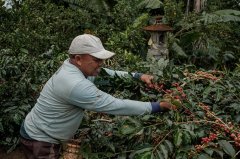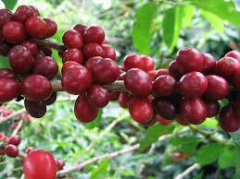Mexican wet process coffee beans flavor characteristics Mexican coffee industry existing environmental problems
One of the drivers of the economy in southeastern Mexico is agriculture. In Sokonusco, Chiapas, coffee is one of the main agricultural products and is traded on the international market. Coffee grown in this area is processed by wet processing to be commercialized as raw coffee. In beneficio (coffee processing plants), water is an essential resource and needs to be used heavily (Matuk et al., 1997; Sokolov,2002 year) because it is used to separate quality coffee berries from defective coffee berries as a method of transporting coffee beans. Coffee berries enter the processing machine, remove the berry shell (pulping) from the coffee grains, and finally wash after fermentation. This process produces one of the smoothest and highest quality coffee (Zuluaga,1989 year; Herrera,2002 year).

Now, many producers of Soconusco choose eco-coffee production, including human health and environmental protection (Pohlan,2005). In addition, over the past few years, increasing attention has been paid to food production free of heavy metals and other pollutants, as well as recent environmental policies related to the protection of aquatic ecosystems, which have raised questions about the quality of water used for coffee processing and the pollutants produced by the agro-industry. Coffee processing plants use water from major regional rivers whose hydrological basins extend from the Madre Mountains to the coastal plains. In addition to providing water, these rivers receive wastewater from coffee processing (Sokolov,2002 year).
Among its many standards, human health and environmental protection (Pohlan,2005). In addition, over the past few years, increasing attention has been paid to food production free of heavy metals and other pollutants, as well as recent environmental policies related to the protection of aquatic ecosystems, which have raised questions about the quality of water used for coffee processing and the pollutants produced by the agro-industry. Coffee processing plants use water from major regional rivers whose hydrological basins extend from the Madre Mountains to the coastal plains. In addition to providing water, these rivers receive wastewater from coffee processing (Sokolov,2002 year). Among its many standards, human health and environmental protection (Pohlan,2005). In addition, over the past few years, increasing attention has been paid to food production free of heavy metals and other pollutants, as well as recent environmental policies related to the protection of aquatic ecosystems, which have raised questions about the quality of water used for coffee processing and the pollutants produced by the agro-industry. Coffee processing plants use water from major regional rivers whose hydrological basins extend from the Madre Mountains to the coastal plains. In addition to providing water, these rivers receive wastewater from coffee processing (Sokolov,2002 year). Over the past few years, increasing attention to food production free of heavy metals and other pollutants, as well as recent environmental policies related to the protection of aquatic ecosystems, have raised problems with the quality of water used for coffee processing, as well as pollutants produced by the agro-industry.

Coffee processing plants use water from major regional rivers whose hydrological basins extend from the Madre Mountains to the coastal plains. In addition to providing water, these rivers receive wastewater from coffee processing (Sokolov,2002 year). Over the past few years, increasing attention to food production free of heavy metals and other pollutants, as well as recent environmental policies related to the protection of aquatic ecosystems, have raised problems with the quality of water used for coffee processing, as well as pollutants produced by the agro-industry. Coffee processing plants use water from major regional rivers whose hydrological basins extend from the Madre Mountains to the coastal plains. In addition to providing water, these rivers receive wastewater from coffee processing (Sokolov,2002 year). It raises questions about the quality of water used for coffee processing and the pollutants produced by the agro-industry.
Coffee processing plants use water from major regional rivers whose hydrological basins extend from the Madre Mountains to the coastal plains. In addition to providing water, these rivers receive wastewater from coffee processing (Sokolov,2002 year). It raises questions about the quality of water used for coffee processing and the pollutants produced by the agro-industry. Coffee processing plants use water from major regional rivers whose hydrological basins extend from the Madre Mountains to the coastal plains. In addition to providing water, these rivers receive wastewater from coffee processing (Sokolov,2002 year).
Important Notice :
前街咖啡 FrontStreet Coffee has moved to new addredd:
FrontStreet Coffee Address: 315,Donghua East Road,GuangZhou
Tel:020 38364473
- Prev

Historical story of Arabica bourbon coffee beans in Mexico description of flavor and taste of Mexican coffee beans
Coffee was first grown in Mexico in the late 1700s. Mexican coffee beans are usually not complex and are used as a mixed base.
- Next

Is Mexican decaf healthy? Decaffeinated? decaffeinated? Processing method of decaf coffee
Coffee is the most popular drink in the world, consuming more than 4000 billion cups a year. It is part of a healthy and balanced diet, and the pleasure experience of drinking coffee plays a key role in many cultures around the world, providing opportunities for friends, family and colleagues to communicate. But there are also some people who are extremely sensitive to caffeine intake, and the existence of decaf coffee is very important to these people.
Related
- Detailed explanation of Jadeite planting Land in Panamanian Jadeite Manor introduction to the grading system of Jadeite competitive bidding, Red bid, Green bid and Rose Summer
- Story of Coffee planting in Brenka region of Costa Rica Stonehenge Manor anaerobic heavy honey treatment of flavor mouth
- What's on the barrel of Blue Mountain Coffee beans?
- Can American coffee also pull flowers? How to use hot American style to pull out a good-looking pattern?
- Can you make a cold extract with coffee beans? What is the right proportion for cold-extracted coffee formula?
- Indonesian PWN Gold Mandrine Coffee Origin Features Flavor How to Chong? Mandolin coffee is American.
- A brief introduction to the flavor characteristics of Brazilian yellow bourbon coffee beans
- What is the effect of different water quality on the flavor of cold-extracted coffee? What kind of water is best for brewing coffee?
- Why do you think of Rose Summer whenever you mention Panamanian coffee?
- Introduction to the characteristics of authentic blue mountain coffee bean producing areas? What is the CIB Coffee Authority in Jamaica?

